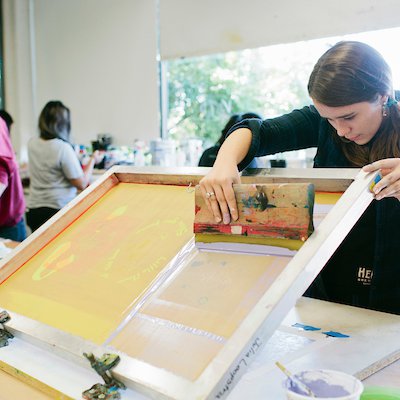The Crucial Overview to Recognizing Screen Printing and Its Versatile Utilizes
Screen printing has an abundant background that dates back to old times, developing right into a sophisticated technique used across different markets today. This overview discovers the complexities of the screen printing process, describing its applications in style, home, and advertising and marketing design - 10:9 Design contact. Comprehending these fundamentals can open up innovative possibility for both commercial and artistic tasks. The following areas will certainly reveal necessary tips and strategies to improve one's screen printing endeavors
The Background of Screen Printing
Screen printing has roots that map back centuries, its development mirrors the technological and imaginative developments of different cultures. Stemming in ancient China, the method was initially made use of for enhancing fabrics and later spread to Japan, where it ended up being indispensable to Ukiyo-e woodblock printing. The method changed to Europe in the 18th century, where it gained popularity amongst artisans and industrial printers. The invention of picture solution in the 20th century transformed screen printing, permitting for more complex layouts and greater performance. Musicians like Andy Warhol additionally thrust its popularity, using the medium to produce iconic jobs that blended commercialism and fine art. By the late 20th century, screen printing had developed itself as a flexible technique, used in style, marketing, and great art. Today, it proceeds to evolve, integrating digital modern technology and increasing its applications across various sectors.
The Screen Printing Process Explained
Screen printing transforms artistic visions into tangible layouts with a series of precise steps. Initially, a picture is produced and then moved onto a screen, commonly constructed from great mesh textile extended over a structure. A light-sensitive emulsion is applied to the screen, which is exposed to light, hardening in locations not covered by the photo. After washing out the unhardened emulsion, a stencil is formed.
Next off, the screen is positioned over the substratum, whether it be material, paper, or another material. Ink is then pressed via the open locations of the stencil making use of a squeegee, depositing the style onto the substrate below. This procedure can be duplicated for multiple colors, calling for different screens for each hue. Ultimately, the published thing is cured making use of warmth to ensure the ink adheres properly, causing a sturdy, vivid layout on-line.
Kinds Of Screen Printing Techniques

Additionally, specialty techniques, such as discharge screen printing, get rid of color from the fabric to create softer prints, while aluminum foil screen printing uses metallic aluminum foil to attain a glossy finish (10:9 Design Company). Each technique supplies unique attributes, catering to numerous innovative requirements and production ranges, inevitably broadening the possibilities within the screen printing domain name
Applications of Screen Printing in Different Industries

Additionally, the signage and advertising and marketing markets utilize screen printing for developing captivating displays and banners. This approach permits vibrant shades and intricate layouts that catch focus. In electronics, screen printing is used for applying conductive inks to circuit boards, necessary for component links. Moreover, the home style industry accepts screen printing to generate unique styles on textiles and wall surface art. read more Generally, screen printing acts as a crucial device across diverse fields, enhancing products with customized and aesthetically appealing graphics.
Tips for Successful Screen Printing Projects
While taking on a screen printing job, mindful attention to information can substantially improve the last outcome. First, choosing high-quality products is necessary; this consists of the screen, inks, and substratums. Using suitable mesh counts can impact ink deposition and information resolution. Preparation is similarly crucial; complete cleaning of screens and proper exposure times assure crisp prints.
Next, accurate enrollment is important for multi-color prints. Making use of positioning tools can aid attain accurate layering. In addition, screening prints on scrap materials before production aids identify prospective concerns without throwing away resources.

Regularly Asked Concerns
What Products Are Ideal for Screen Printing on Material?
Cotton and polyester blends are excellent for screen printing on textile as a result of their sturdiness and ink absorption. Furthermore, specialized materials like silk or canvas can produce distinct structures and finishes, improving the general style top quality.
Exactly how Do I Tidy and Maintain Screen Printing Devices?
To maintain and clean screen printing equipment, one ought to on a regular basis clean screens with appropriate solvents, examine squeegees for wear, oil relocating components, and shop all products in a completely dry, dust-free setting to lengthen their life-span.
What Are the Ecological Effects of Screen Printing?
Screen printing can have substantial environmental effects, including chemical waste from inks and solvents, water usage during cleansing procedures, and energy consumption. Sustainable practices and eco-friendly materials are important sign and print for lessening these negative results.
Can Screen Printing Be Done in the house Properly?
Screen printing can be efficiently done at home with the ideal products and methods. Hobbyists can create top quality prints, though success depends upon their skill level, devices, and understanding of the process included.
What Are the Costs Linked With Starting a Display Printing Company?

Starting a screen printing organization entails costs for equipment, materials, and work space. First costs typically range from a couple of hundred to numerous thousand dollars, depending upon the range, top quality of equipment, and preferred production ability.
Screen printing has a rich history that dates back to old times, progressing right into a sophisticated technique utilized across different markets today. An additional strategy, rotating screen printing, uses round displays, helping with continual printing on fabric rolls, thus improving effectiveness for see post large-scale productions. Furthermore, specialty methods, such as discharge screen printing, eliminate dye from the material to produce softer prints, while foil screen printing applies metallic foil to achieve a glossy finish. In the fashion sector, screen printing is widely used to develop dynamic designs on clothing, enabling brand names to showcase their unique styles. Cotton and polyester blends are optimal for screen printing on material due to their toughness and ink absorption.